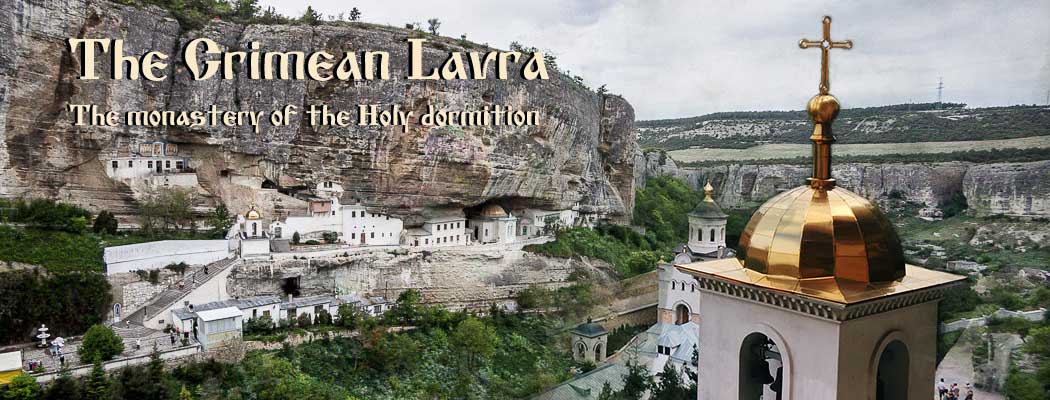![]()
PANAGIA OR THE DORMITION SKETE
OF BAKHCHISARAY
IN THE CRIMEA
(The brief historical description)
1908
p.1
-
Chapter 1
The monastery of the Dormition of Bakhchisaray is located not far to the north of the city of Bakhchisaray,
in the deep gorge that the Tartars call Meriem (Maryms gorge), surrounded on both sides by steep, towering cliffs rising to a height of 70 sagenes. The monastery lies in one of Crimeas emptiest but most impressive landscapes. According to eyewitness accounts, its situation is reminiscent of that of Guorgui Hozevits Carthusian monastery near Jerusalem, famous for its wild and barren surroundings. The remains of various plant species found in the ravine are proof that in ancient times, this land was covered by a thick forest which not even the presence of the neighbouring khans residence managed to diminish.
During previous centuries a Greek colony found shelter at the foot of the rock; today all that remains are the caverns where the Greeks lived. The place was called Marioupol, or Mary village, after the name of the icon of the Theotokos Panaguia which appeared miraculously on the rocks. The village was mentioned already in the late 16th century in the famous Book of the Big Plan. In Tavrida, in 1625, the embassy travel notes mention that, at the end of their official mission to the Khans residence before returning to their country, our ambassadors gave thanksgiving prayers in Mary village, on the rock of the Dormition. The Greek Christians suffered constant oppression from their neighbours, the Tartar Muslims. Under the Tartar domination, the Christians suffered their misfortune with extreme abnegation. Some sought refuge in woods and caverns in order to devote their lives to God while others founded monasteries. These latter, being the very foundation of the Christians religious and moral life, were particularly subject to attack by the Tartars, who destroyed them and burnt the monks books. The more the Christians built, the more the Tartars destroyed. In the 15th century most of southern Crimea, including all its Christian inhabitants, fell under Turkish domination. The Greeks found themselves living between two Islamic people: the Turks and the Tartars. This was the beginning of difficult times for the Christians of Crimea. Relations were strained between Turks and Tartars on the one hand, and Christians on the other, who suffered acute hardship and persecution. The Christians from Tavrida lost their courage in the unequal struggle against the Muslims, but just when all hope of saving their faith was on the point of being extinguished , the image of the Theotokos appeared on the inaccessible rock of Bakhchisaray, in the very heart of Islamic territory.
One legend, as conveyed by Russian writers of the 18th century relates : Once upon a time, on these rocky mountains (where the monastery lies today) there was a dragon which devoured both men and beasts, and forced people to leave those lands; but the Greeks and the Jinn who were also living there at the time prayed to the Theotokos, imploring her to deliver them from the dragon. One night a candle light was seen on the rock. Not being able to climb the steep mountain, the people carved a ladder in the rock. On reaching the place from where the candle was shining they found the icon of the Theotokos and the lit candle in front of it. Rejoicing at this sight, they gave thanks to the Lord who had delivered his people from the dragon. They cut the dragon into pieces and burnt it. To this day, the inhabitants still meet in order to pray to the Theotokos.
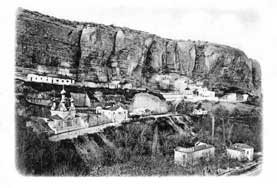
p.2
-
Another legend says :"Once upon a time, a prince had a shepherd called Mikhail, who led his flock of sheep to the valley of the Dormition and saw on the rock, at a height of 10 metres, the icon of the Theotokos and a candle burning in front of it. Astonished by this miracle he brought the tidings to his superiors and, when this came to the attention of the prince, he ordered that the icon be taken away and transferred to a house in the neighbouring mountains. Despite the veneration he accorded the icon, it disappeared from the house the following day and regained its place on the rock. The same thing happened every time the icon was removed from its setting on the rock. Finally it became apparent that the Theotokos would not accept to leave the place where her image had appeared for the first time. Without further delay, it was decided to build a small chapel in the rock at the place where the holy icon had appeared. A cavern was carved into the rock with steps leading to it. In this cavern the newly-appeared icon was placed".
The apparition of the holy icon occurred on the 15th of August and the new chapel was consecrated to the Dormition of the Mother of God. This miraculous apparition of the icon of the Theotokos and the foundation of the Dormition Church date back to the mid 15th century, but traces remain of the existence of a Salatchik monastery on the same site at the end of the 16th century. At that time the monastery sent an envoy to Moscow in order to ask the tsar Fiodor Ioanovich for alms.
In the early 17th century, the embassy sources inform us of the existence of the Dormition church in the cavern, and quoting a letter of prince Prozorovski to Roumiantsev-Zadounaiski dated 31 of May 1777:"From ancient times, not far from Bakhchisaray, there has been a small Greek church carved into the mountain which, despite restoration, is falling into decay, and the bishop, after meeting the prince, has made known his decision to build a new and more convenient one".
The miraculous apparition of the holy icon brought Divine Grace and the protection of the Theotokos herself upon the Christians. The fight was renewed for the profession of the holy faith with the fervent belief that the Holy Theotokos would cover them with her protection. The temple carved into the rock where the icon had appeared for the first time became a sanctuary of prayer: it strengthened their spirit in the face of terrible torture and in this temple they felt as members of one family of the Heavenly Father, protected by Divine Providence. The high spiritual significance of the temple decided many Christians to settle in the neighbourhood and to consecrate themselves entirely to God. This was the origin of the Monastery of Bakhchisaray. It united the Christians and helped to strengthen their faith in the face of opposition from the surrounding Islam communities. It even became a metropolitan seat. Without knowing exactly when the seat was transferred there, the fact that the last Metropolitan, Ignatie, lived at Bakhchisaray proof that the transfer had been made before his time.
The Monastery of Bakhchisaray thus became the centre of spiritual life for the Christians of the Crimean khanate and served as a guide for their spiritual improvement. But for the Tartar domination, it would have become an imposing and well-equipped monastery, but the Muslims forbade the Christians even to erect crosses on the church towers and forced them into back-breaking labour. All trace of the ancient Greek culture and civilisation disappeared as most of the inhabitants assimilated Tartar language and customs. Temples and palaces replaced huts and caverns. When tensions in Greek-Tartar relations reached a climax, the Greeks sought help from Russia. Having lived under Tartar rule themselves, the Russians had always had sympathy with their Greek fellow-Christians. The Greeks had been receiving aid from Moscow for a long time. They realised that only the Russians were in a position to defend them (war between Russia and Turkey had just broken out). In 1778, having expressed his desire to meet Metropolitan Ignatie, the commanding officer of the Russian army, Mr Roumiantsev, was introduced to the revered head of the Crimean Christians, and suggested that he and all the Christians of Crimea should move to Russian territory.
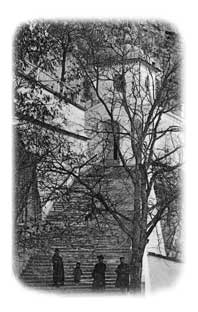
p.3
-
On 23rd of April, Easter Day, after liturgy in the Dormition Church of the present monastery, the Metropolitan presented this proposal to the congregation. The news of the Christians exodus spread throughout the whole of Crimea. The Tartars viewed the departure of the Christians with extreme indignation, and railed against the Khan who was watching the Russian manoeuvres with indifference. But thanks to the vigilance and letters of exhortation of Metropolitan Ignati, as well as to the priests he had deployed in the villages for this purpose, the Christians decided unanimously to leave Crimea forever and move to Russian land.
At that time the monastery of the Dormition of Bakhchisara became once again an important centre for Crimean Christians. The sons of Pantikopei, Feodossia and Khersones gathered at the monastery for a last prayer to the Holy Theotokos, who had for centuries protected them with her veil against Muslim attack. The Greek's departure from the beloved region of Tavrida was difficult.
The Metropolitan gave prayers of thanksgiving and farewell. After the prayer, the Metropolitan, the priests and all the Christian followers took the miraculous icon of the Theotokos and set off in a long procession, accompanied by songs and prayers, over mountains and across plains, leaving forever their native country, with everything that was precious to them, for Novorussia.
Here, not far from Marioupol city, the holy icon from the Monastery of the Dormition can be found today. This event led to the closure of the monastery of Tavrida for a period. In 1781, the Greek priest Konstantin Spirandi came from Antiochia to the Bouiuk-Lokbet wharf. Hearing of his arrival, the Christians who were still living in Crimea asked him to stay with them in order to serve at the monastery (the church of Saint Elias in Bakhchisaray having fallen down after the Greeks departure) At that time, with Crimea under Russian domination and Russian troops in Bakhchisaray, the need for religious services increased. The priest agreed to stay with the Greeks, and until 1800 he lived near the church of the monastery. When the Greeks built their own temple in Bakhchisaray city, Konstantin Spirandi moved to Bakhchisaray where he lived until his death, leading the Christians in their spiritul observance. He is buried under the rock facing the church of the Dormition. It was at this time that renovation work on the monastery began. Colonel Totovich, commander of Bakhchisaray, donated a holy iconostasis; the military governor, General Kahovsky, had the Holy Doors erected at his own charge, and the church warden Stefan Kaliga extended the cavern temple and repaired the steps and balcony. In 1800 a temple consecrated to Saint Nicolas the Thaumatourgos was built and the monastery was transformed into a cemetery church. It held this status for 50 years, annexed to the synodical urban college and being forbidden the right to have its own priests. But Divine Providence did not forsake the church during this time and manifested her invisible presence through miraculous power, protecting the suffering people who were constantly visiting this sacred place.
After the Greeks had left the monastery with the miraculous icon, new miracles were witnessed from the icon of the Dormition of the Theotokos in the Church of the Dormition. This icon had been donated by the Serbian commander of Bakhchisaray, Colonel Totovich. Among the countless miracles produced in the presence of the starets, Archpriest Konstantin Spirandi, who died at the age of 80, two particularly remarkable ones are worth mentioning. A Greek from Anatolia had a 16-year-old son whose arms and legs had been deformed for several years by a severe disease.
One night in his sleep, the father, who was distressed by his sons pain, heard a voice telling him to take his son to the rock of the Dormition to be healed. After reciting the Akathistos Hymn in front of the icon of the Dormition, and having kissed the icon, the disabled child felt an extraordinary flow of force through his whole body. Although he was carried from the rock by his parents, an hour later, as the family were starting on their way home, the child suddenly stretched his arms and legs and jumped out of the coach. He ran and jumped for joy, crying out that the Theotokos had healed him. Similarly, a sick officer from Evpatoria whose name was Anastasias Doussi, was possessed by an evil spirit.
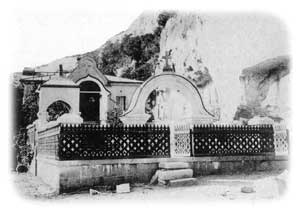
p.4
-
He was led to the rock with his hands and feet bound, and taken into the cavern temple. There, prayers were read over him designed to deliver him from the evil spirit, and after the apposition of the Dormiton icon, the sick man came to his senses. He started talking sensibly, saying that thanks to merciful God he was delivered from the evil spirit who had tortured him. He returned home with an untroubled mind and vowed to worship the icon of the Dormition ever after. Such signs of Gods miraculous power reinforced the veneration by Crimeas orthodox inhabitants of the rock of the Dormition, still very much in evidence today, especially on 15th august, feast day of the Dormition, when pilgrims gather from all over Crimea. Few travellers to Crimea do not visit the rock and its old cavern temple. Through the centuries the sacred rock has received among its visitors, the Russian tsars and almost all the members of the High Court. Mention should be made of a moving deed by the late emperor Alexandre Blagoslovenni. Visiting the cavern temple in 1818, he asked the Archpriest Spirandi who had invited him: "where is the place of the holy icons apparition?" The starets took him out of the temple onto the balcony and pointed to Theotokos face on the wall. The royal pilgrim ordered a chair and a candle, climbed up to the icon and kissed it with special veneration, then placing the burning candle in front of it with his own hand.
The same monastery is known as Mariem-Anai, that is Little Mother Mary.
By the author of this article: Panaguia, translated from Greek, means Very Holy or All Holy name given to the Mother of God in prayers (Bedside book of the priest Publishing House of the Patriarchate of Moscow).
Generally, the Greeks give the name Panaguia to the Theotokos, which means All Holy (A New Table of the Law or exegesis of the Church, of liturgy and of all the services and ecclesiastical instruments belonging to the archbishop of Nijni Novgorod and Arzamas Veniamin. SPB.1889.p. 472).
- The Book of the Big Plan. Moscow . 1846.
- Notes of the Odessa Society of History and Antiquities.1850. V.2.p. 611.
- By the author of this article: in 1475 the army of the Turkish sultan Mohammed II seized hold of the Gne colonies and the Feodoro principality, situated in southern and respectively, eastern Crimea . Not all the Christians suffered from Turkish domination. Part of them remained on the territory of the Crimean Khanate, a client to the Ottoman Empire . (Andre Jazykov. The History of the Scythes. See also TheHistory of the Scythes by Llzov, 2nd part, Book 4, p. 4)
- In the Moscow records of foreign affairs, there is a document related to the affairs of the Crimean Embassy where we may read the following: "on 27th May 1596, according to the Ukase of the Grand Prince of all the Russians, Fiodor Ivanovitch, in memory of Boliarine, the Prince Ivan Vasilievitch Sitskii, arrived from the Crimean Monastery of the All Pure Mother of God in Salatchik, at the sovereigns residence, Tsar and Grand Prince of all the Russians, the Greek Pasqualii, attended by messengers from Crimea to ask for alms, but, before his arrival, there had been sent to this monastery of the All Pure in Salatchik, according to the Sovereigns charter, a donation of 15 roubles. At present, the boyars ordered the sending of the Greek Pasqualii with 15 roubles for the monastery. Before the conquest of Crimea by the Russians, the Crimean Orthodox Church had depended upon the Patriarchate of Constantinople in whose records we may find details on the subject.
The miraculous icon bears the name of the Bakhchisaray Icon of the Theotokos, but it is also known as Panaguia, icon of the Theotokos of Crimea or of Marioupol.
By the author of this article: the distorted name of the Biyuk-Lambat village. The 1st issue of 1880 mentions another colony Koutchouk-Lambat. Both were situated on the southern coast of Crimea , between the Ayou-Dag and the Castel mountains. .
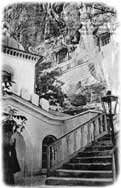
p.5
-
The Monastery of the Dormition had the honour of receiving the following highly ranked personalities:
His majesty the Tsar Alexander I in 1818 and 1825;
The Emperor Nicolas I on 26th June 1817 and in September 1837;
The Empress Alexandra Fiodorovna on 13th September 1837
The heir Tsarevitch Alexander Nikolaievitch on 14th September 1837;
The Grand Duchess Maria Nicolaievna on 13th September 1837;
The Grand Duchess Maria Pavlovna on 30th May 1838;
The Grand Duchess Elena Pavlovna on 1st September 1838
The Grand Prince Constantin Nikolaievitch on 2nd September 1845 and on 19th May 1850;
The Grand Princes Nicolas and Mikhail Pavlovitch on 1st October 1854;
His Majesty the Duke George of Mecklenburg on 1st November 1855;
The Emperor Alexander II and the Empress Maria Alexandrovna and their august children the Grand Prince Serguei Alexandrovitch and the Grand Princess Ksenia Alexandrovna on 4th May 1886.
By the author of this article: The first member of the Romanov dynasty who visited the Rock of the Dormition was the Empress Catherine II who is said to have been praying in the cavern temple of the Monastery with the Roman Emperor Joseph II on 21st May 1787. (A. Oumanets, Historical reports on Crimea. 1887. Published in the magazine The shores of Tavrida, 1992, N 1, p. 253). Doing his duty as a sovereign, his imperial Majesty the Tsar Nicolas II paid several visits to the Monastery of the Dormition. The last time he went to the Monastery was August 30, 1931, and he was accompanied by the Grand Duchess Olga Alexandrovna and the Grand Princesses Olga Nikolaievna, Tatiana Nikolaievna and Anastasia Nikolaievna (The voice of Crimea magazine, 19213, N 5, p.20).
Chapter II
The opening day of the Monastery of the Dormition in Bakhchisaray
The Monastery of the Dormition in Bakhchisaray opened in 1850 due to the following event: In 1848, Innokenti, Archbishop of Kharkov, ascended the pulpit of Kherson and Tavrida.
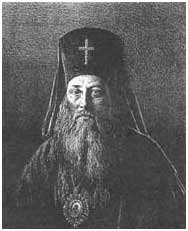
Visiting Crimea, his Eminence noticed the decay of the ancient sacred places in the Tavrida mountains and proposed the restoration of the most important part of them and the introduction of Athonite monastic rules.
The famous rock of the Dormition, known since time immemorial and frequently visited by pilgrims, became the site of the monastery which ruled over all the other sacred places.
Archbishp Innokentis proposal was presented to the Holy Synod which approved and ratified it on 15th of April 1850 and on 15th of August the Monastery of the Dormition was founded in the presence of a large number of witnesses.
p.6
-
One of the witnesses who took part in the religious ceremony described it as follows:"The rumour about the restoration of the ancient sacred places had already spread throughout our mountains since spring and it rejoiced all those who held those places in high esteem. They were really worth setting up again from ruins and recovering their initial magnificence. That is why, since early August, faithful visitors and pilgrims gathered in the cavern of the Dormition. On 13th of August bishop Innokenti arrived and on 14th of August even the revered starets bishop, the Greek Metropolitan Agathangel, came from Sebastopol to represent the old Mount Athos and to consecrate the new. As the church became extremely crowded Vigils took place on a small square in front of it so that the people sitting in rows all over the mount be able not only to hear but also to watch the religious ceremony.
At the right moment the clergy and all the people present received the Holy Unction from Archbishop Innokenti, and those who were at the foot of the Mount were anointed by the other two archpriests. The ceremony started at 5.00 p.m. and continued until midnight in the only light of candles brought by the people and lit by their inextinguishable faith. It reminded of the first Christians gatherings for prayer time in caverns and deserts.
On 15th of August, in the cathedral of Bakhchisaray, the local archpriest Konstantin Spirandi celebrated the first liturgy, and at 9.00 a.m. the religious procession made for the rock, taking a very narrow and meandering road, bordered by the eaves of virgin rocks on one side and by the peaceful shadows of those thick woods so widely spread in Bakhchisaray, on the other side. The clergymen dressed in white and coming from different counties of Crimea, the great number of horse mounted men and street lamps as well as the choir singing in festive garments provided the procession a remarkable glamour. But the main attraction of the procession was the holy icon of the Dormition of the Theotokos, offered by the Kiev Lavra for the blessing of the new monastery in Crimea. The two eldest archpriests in the procession were carrying the icon. At the foot of the rock the future dwellers of the monastery welcomed the bishop with crosses and blessed water. The Divine Liturgy began at the same moment on the rock and was celebrated by the bishop and Metropolitan Agathangel. At the end of the divine service, Archbishop Innokenti, the Metropolitan and all the clergymen made the traditional prayer for the foundation of a new monastery in front of the Dormition temple.
Later, the two bishops raised a wooden cross with the inscription of the monastery's opening date. Archbishop Innokenti went into the ambo and delivered a sermon imbued with the depth of pastoral feelings which highly impressed the audience:
"What is the reason for our being here?" - he asked. "In front of us we have the rock and its seemingly antediluvian peak, behind we have the cliffs with their inaccessible height, all around us, the woods and the desert. And all these pilgrims flowed towards these rocks and cliffs and gathered into this desert. What is the reason for your coming here, brothers? I am sure that you are not here for any material reason or interest. What could you expect to find in this desert? It is not for the body or for food's sake that you came here either; what kind of food could you find among these barren rocks? The real reason for our being here is our strong faith in our Lord and Saviour whose name is magnified in this place; what brings us here is our ardent love for His All Holy Mother who chose this rock as her dwelling place by the apparition of her icon a long time ago. In the name of the Lord and of His All Holy Mother we bless you, our brothers, for your faith and for the efforts you are making now and you made every year, even at times when everybody withdrew from this sacred place.
Despite all the hardships and all contrary circumstances you went on believing and loving this holy rock. Now the Lord fulfilled your wish: this place that you mostly love will recover its ancient rank and magnificence.
From now on, being able to visit this place all the time you will find here not only the prayer and the divine service, but also the monastic way of life according to the Athonite rule. Who has not heard about this marvelous mount where day and night, thousands of kind and humble anchorites address their fervent prayers to the Lord for peace on Earth? From now on we shall have the consolation to find the image of the old Athos within the very confines of our country.
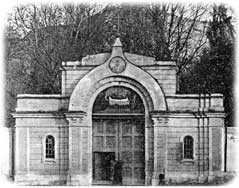
p.7
-
Oh, what a glorious future for our mountains! I think I can see the accomplishment of what now only begins! I see Saint Vladimir visiting in spirit the temple where he and all the Russian people was baptized and converted to the Orthodox faith. I see saint Stephen of Souroge finding a shelter for his faithful flock in this valley where he spread the holy dogmas at the time of Iconoclasm. I see the almost forgotten seven holy martyrs of Kherson, who are now invisibly meeting their disciples in their churches in order to teach them the example of their own lives. I can see the Popes of Rome, Clement and Martin, coming back to their peaceful, but also painful hermitage and finding it transformed into a privileged place for the divine service. And finally I can see the name of the Disciple and Apostle who first pronounced Christs name in our mountains and then in the whole Russia. May our churches always bear his name with honour!
Blessed be our Lord who deigned to look at this place in our mountains! Now it is up to us to make grow the spiritual fruit of this divine and vivifying vine about which it is said: "I am the true vine and you are the branches. We are grateful to the All Faithful Sovereign who considered our prayer and ordered that a sanctuary abandoned for centuries should be set up again! So let us bring together our fervent prayers before the Lord, dear brothers, and may our good hopes come true and our efforts bear fruit. If the Lord does not build this house Himself for the glory of His name, all our efforts will be vain.
Oh Lord, you who see the depth of heart and thought, you can also see our good will to restore these sacred places in our mountains, therefore we beg you to look from the Height of your All Mighty Glory and send your Holy Grace upon this place and all the other places waiting for restoration!
Mother of God, you who chose to dwell on Mount Athos, I beg you to cover our mountains with your holy veil and thus take them into your motherly protection.
Holy Fathers and God servants, martyrs and practitioners of faith, who sprinkled and consecrated our land with your blood and tears, come and give us strength so that Christs Cross for which you gave your life may rise again on these mountains. Amen".
At the end of the procession people sang wishing a long life to the faithful Tsar and to the whole Illustrious House, the Holy Synod, the benefactors of the monastery and to all the Orthodox Christians.
When the event seemed to be finished, suddenly, several persons wearing monk cloaks came out of the priests range and kneeled in front of the archpriests for blessing of their future spiritual actions. Helping them to stand up again the archbishop addressed them a particularly touching sermon starting as follows:" By your great number and humble appearance you represent, my brothers, this little flock about which our Saviour says in the Gospel: Do not be afraid, little flock, for thy Father gave you the Kingdom".
Then the Archbishop blessed the future monks with the icon of Saint Mitrophane and thus the procession ended.
By the author of this article: Innokenti, Archbishop of Kherson and Tavrida, is a famous theologian, professor of the Russian Orthodox Church and a Russian patriot, Ivan Alexeevitch Borisov by real name. He was born in the Orlov province in 1800 in a priests family. He studied at the seminaries of Orlov and Kiev and obtained a doctors degree in theology. Since 1847 he had been a member of the Holy Synod. He successively was the dean of the Saint Alexander Nevski seminary in Saint Petersburg and the president of the Theological Academy in Kiev and Tavrida.
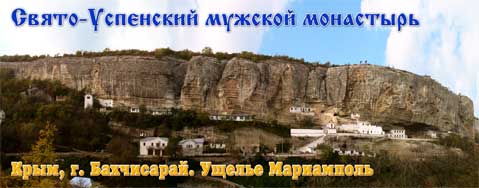
p.8
-
Archbishop Innokenti was famous for his rhetorical talent and for his erudition. He left many written works. The love of Christs servant for his flock became particularly fervent during the terrifying events of the Crimean war and the first defensive war at Sebastopol in 1854-55. The patriotic deeds of Archbishop Innokenti morally encouraged those who fought for their country. In recognition of the worthy service he vowed to his church and country, he was conferred several titles and a diamond cross. He died in 1857 in Odessa. Ever since, on the Name-Day of the parish Vigils have been celebrated in this place.
Chapter III
The present situation of the Monastery of the Dormition
It is 50 years now since the monastery opened and 13 superiors succeeded during this time:
Archimandrite Polycarpe (185-1853);
Archimandrite Mitrophane (1853-1854);
Archimandrite Veniamine (1854-1855);
Archimandrite Nicola (1855-1864);
Archimandrite Dionissi (1864-1868);
Hieromonk Flaviane (1868-1869), now vicar Archbishop of Georgia;
Archimandrite Mikhael (1869-1871);
Hieromonk Flaviane for the second time (1871-1873);
Archimandrite Antoni (1873-1877);
Archimandrite Dionissi for the second time (1877-1883);
Hieromonk Evfimi (1883-1885);
Hieromonk Guerman (1885-1887);
Hegoumenos Andre (1887-1890);
Archimandrite Isidore (1890-1900);
Hegoumenos of Feodossia (from 26th of September 1900 to 6th of February 1901);
Hieromonk Arkadi - since 6th of February 1901.
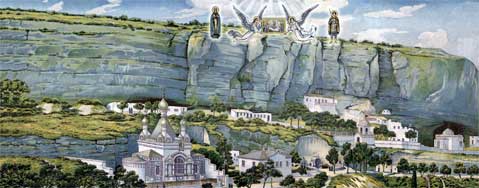
p.9
-
In the beginning the monastery possessed only one church and three cells in a rock, but by now it became a real City of God, including several churches where the name of the Lord and of His All Holy Mother is magnified. It also comprises a small piece of land for farming. Presently the monastery owns the following buildings:
A. The churches of the monastery There are five churches with one altar.
a) the cavern temple consecrated to the Holy Dormition of the Theotokos, on the place where the miraculous icon of the Mother of God "Panaguia" appeared. This temple also owns a number of holy icons particularly venerated:
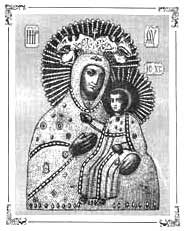
1. The Holy Icon of the Dormition on the iconostasis, 1archine high (0,71 cm) and 3,5 verchoks large (1 verchok = 4,4 cm), made of silver chasuble. The icon was offered by the commander of Bakhchisaray, colonel Totovitch. Many deeply faithful Christians were spiritually and physically healed by the intercession of the icon and many people made gold or silver offerings to the icon hoping to recover health.
2. A copy of the Holy Icon "Panaguia", 1 archine and 2 verchoks high and 12 verchoks large, made of silver chasuble and decorated with pearls and precious stones. The chasuble was offered by the general-lieutenants wife, Evdokia Martynova, on 24th of March 1856.
3. A copy of the miraculous icon of the Theotokos Kiev Petchersk, 8 verchoks high and 6 verchoks large, made of gold-plated silver chasuble, sent from the Kiev Petchersk Lavra by Metropolitan Filaret on the foundation day of the monastery. On the Name-Day of the monastery, the 15th of August, Vigils are celebrated in front of this icon, on the church square.
4. An icon of the Saviour containing 84 relics from the bodies of different saints, 15 verchoks high and 12 verchoks large, sent by the Monastery of the Theotokos in Korsoun for the foundation day of the Lavra.
5. A Cross of our Lord Jesus Christ made of three types of wood: cypress, filbert and cedar and bearing the following inscription: "Sent by the Old Athos to the New for the blessing of its foundation in 1850".
6. The icon of the Theotokos with the child on the right side, two angels and the 7 martyrs of Kherson, painted on the rock where the miraculous icon "Panaguia" appeared. A candle is burning day and night in front of it.
On the square facing the temple of the Holy Dormition there is a church steeple containing a bell 58 pouds big (I poud = 16,38 kg).
b) The church of the Saint Apostle and Evangelist Mark, cut into the cavern rock towering the Dormition church in 1859 under the rule of Archimandrite Nicolas and thanks to the donation of the clerk of Simferopol, Marc Aivazov. Its Name-Day is celebrated on 25th April. Higher than the church, in the cavern, the sacristy and the library of the monastery are to be found.
c) The church of the Holy Emperors and equal to the Apostles, Constantine the Great and his mother Helen, built in the cavern in 1878 under Archimandrite Nicolas, thanks to the haste and extreme devotion of Elizabeth Berkova, the young daughter of a member of the Synodal College. When she died, in 1878, she was buried not far from the church she had built. This charitable woman also offered the monastery a hostel in Simferopol which encloses the church of the Presentation of the Virgin Mary; the divine service is celebrated every day and the Name-Day is on 21st November.
d) The church of Saint George whose Name-Day is on 23rd April. Next to this church there are two cemeteries: a civil and a military one. Several generals and other famous personalities who gave their lives to God and to their country during the Crimea war of 1853-56.
e) A fifth little church was built on the average square of the monastery in 1896 under the rule of Archimandrite Isidore and thanks to the donations of the archbishop of Tavrida and Simferopol, Martinien. It bore the name of the first hierarch of Irkoutsk, Innokenti, that the Archbishop of Kherson and Tavrida, Innokenti, particularly venerated as his homonymous protector. This church was built in the memory of the illustrious Russian hierarch and personality, the Archbishop of Kherson and Tavrida, Innokenti, in recognition for his gifts and solicitude about the erection of the churches in Tavrida and especially for the monastic complex.
p.10
-
B. The Buildings of the Monastery
The most important building is the Abbots house, built on the medium square of the monastery under Archimandrite Nicolas, in 1862. About the same moment the two-leveled stone building, including a refectory for the monks, a kitchen with bakery and six monk cells were finished. The Archimandrites Polycarpe and Mitrophane built two cells under the rock and cut other sixteen into the rock for the other brothers. One of these cells contains an oven for the preparation of prosphoros. The cells in the rock are wet and not very fit to living conditions.
In 1867, Archimandrite Dionissi built other two stone houses on two levels on the lower side of the slope. These were meant to receive the visitors. He also erected other buildings for farming on the upper side of the slope and the holy gates with two cells at the entrance of the monastery. The icon of the Holy Dormition with an ever burning candle was placed above the gates. A. The fountains and wells of the monastery
One kilometer far from the monastery, climbing up the ravine, there is a spring at 1,5 sagene depth into the rock. In 1896, Archimandrite Isidore repaired an ancient water pipe coming from the spring. Not far from the spring there is a chapel-like pool bearing a cross and an icon of the Dormition. The water in the pool comes from the spring through the iron water pipe and then flows into a fountain laid out on the medium square of the monastery. The latter represents a one-stone jar of 1 sagene diameter bearing a bronze cross; the pure and vivid fountain water springs from the upper part of the cross. The jar is enclosed on three sides by a dome upon which there is an icon of the Dormition of the Theotokos fit into a stone nest.
The same year, Archimandrite Isidore built a water pipe to provide water for the hostel, the kitchen and the bathroom of the monastery. A well was built near the hostel and another one near the refectory.
B. The architecture of the monastery
The monastery is built on three levels.
On the highest level there are three churches: the church of the Dormition, the church of the Saint Evangelist Mark and the church of the Saints Equal to the Apostles, Constantine and Helen, 13 cavern cells and a steeple.
On the intermediary level there are Saint Innokentis church, the house of the Abbot (the superior of the monastery) with 3 wells and 3 cavern cells.
On the lowest level there are: the wing of the refectory with its dependencies, two wings for visitors (hostels), the holy gates and two wells.
On the left side of the ravine there are: Saint Georges church with its two cemeteries, a civil and a military one. The part of the ravine situated on the monastery land and especially its right side where lies the main sanctuary present a magnificent landscape, being coved with different trees from Southern Crimea where lots of birds are singing.
In the southern part of the monastery, in the valley, there is a mostly beautiful orchard which reminds of Gethsemani near old Jerusalem. For this reason, in 1867, a chapel was built next to the orchard and was called the chapel of Gethsemani. Only junipers grow on the mountaintop and an 83-steps ladder makes it accessible to visitors.
C. Saint Anastasia convent and collective house
In the early 1853 the Monastery of the Dormition was given the convent and collective house of Saint Anastasia on the Katcha river, 8 verstes far from the monastic complex. It included two churches: one consecrated to Saint Anastasia with its Name-Day on 22nd of December, and a smaller one, cut into the rock, and consecrated to Saint Sophie and her martyr daughters Pistis, Elpis and Agape. Its Name-Day is celebrated on 17th of September. There is a divine service every day in the convent.
D. The brothers at the Monastery of the Dormition
Presently the Monastery of the Holy Dormition, the hostel of Simferopol and the convent of Saint Anastasia shelter 60 brothers. These are: the hieromonk Arkadi (replacing the superior of the monastery), 7 hieromonks, 5 hierodeacons, 7 monks and 40 novices.
At the monastery the liturgy is celebrated every day following the rules of Mount Athos. The cleaning is made by the brothers who are sometimes helped by the pilgrims.
"Queen of the Earth, You who chose this holy rock as a dwelling, look at this holy monastery and see how it grew and extended, look at these holy churches where your Name and that of your beloved Son and our Lord are ceaselessly magnified. Look at the spiritual deeds of our brothers, at their continuous prayers and chants, their tears of repentance and humility, their ardent love for You and for your Son, our Lord Jesus Christ. Take this place under your all powerful protection and bestow long days upon it now and forever and ever. Amen".
By the author of this article:
*The saint martyrs of Kherson, Ephrem, Basil, Evgueny, Eppidi, Agaphodor, Ephri and Capiton were at different times bishops of Kherson and Tavrida. They preached the Gospel and sealed their sermon by a martyrs death in the city where later on the candle of true faith was lit for the Russians. (Meneon. March. Ch 1. The Moscow Patriarchate Publishing House.1984, p 202). The memory of the seven saint martyrs of Kherson is celebrated on 7th March.
*During the defensive war of Sebastopol, in 1854-1855, a military hospital opened at the monastery. Among the heroes tombs there are two remarkable ones: the tomb of the adjutant general P. Vraevski and that of the major general Wierman, who died on 4th August 1855 in the battle of the Black River.
*He died in 1898 at the Monastery of Kherson.

The Monastery of the Holy Dormition in 1890.
